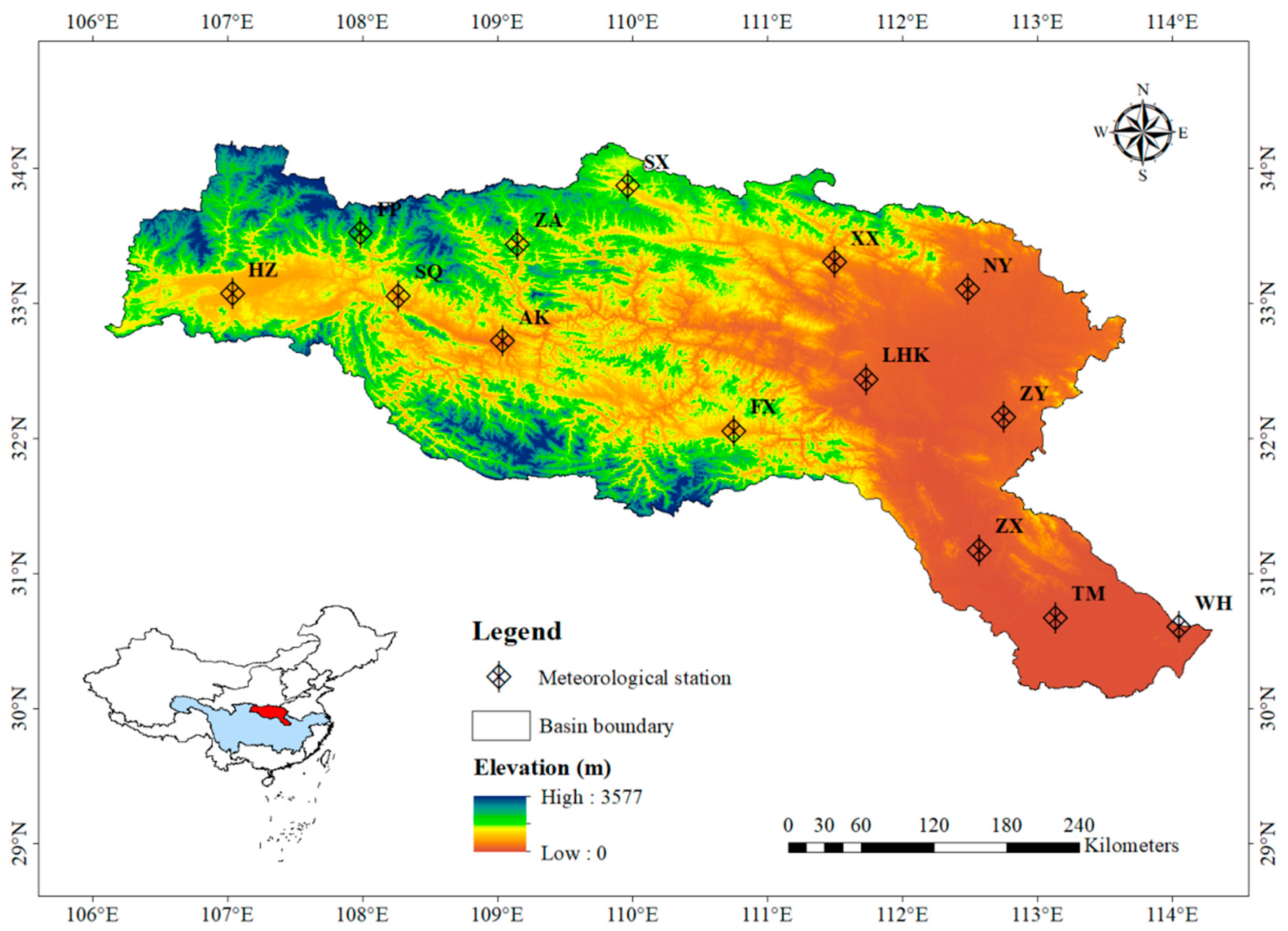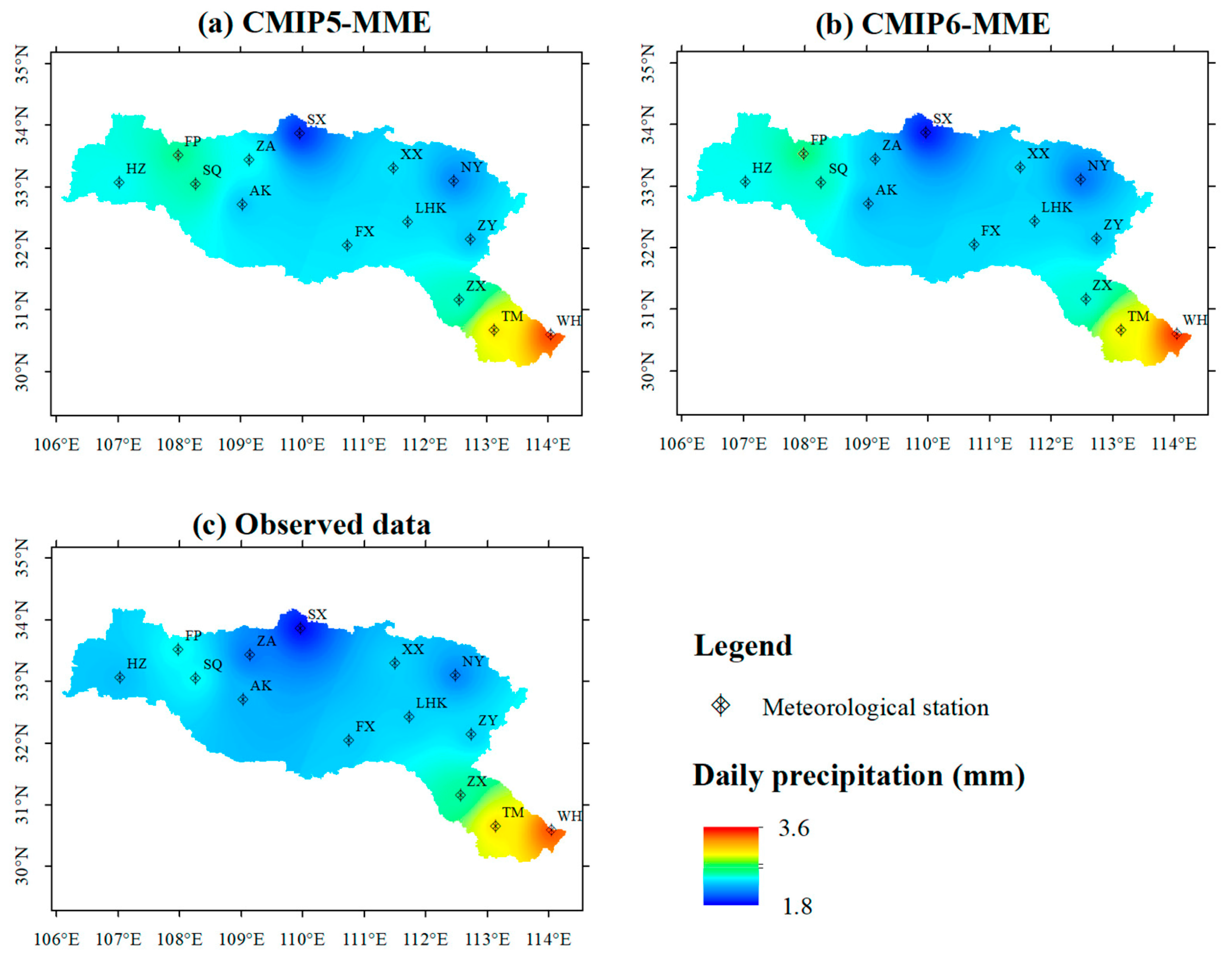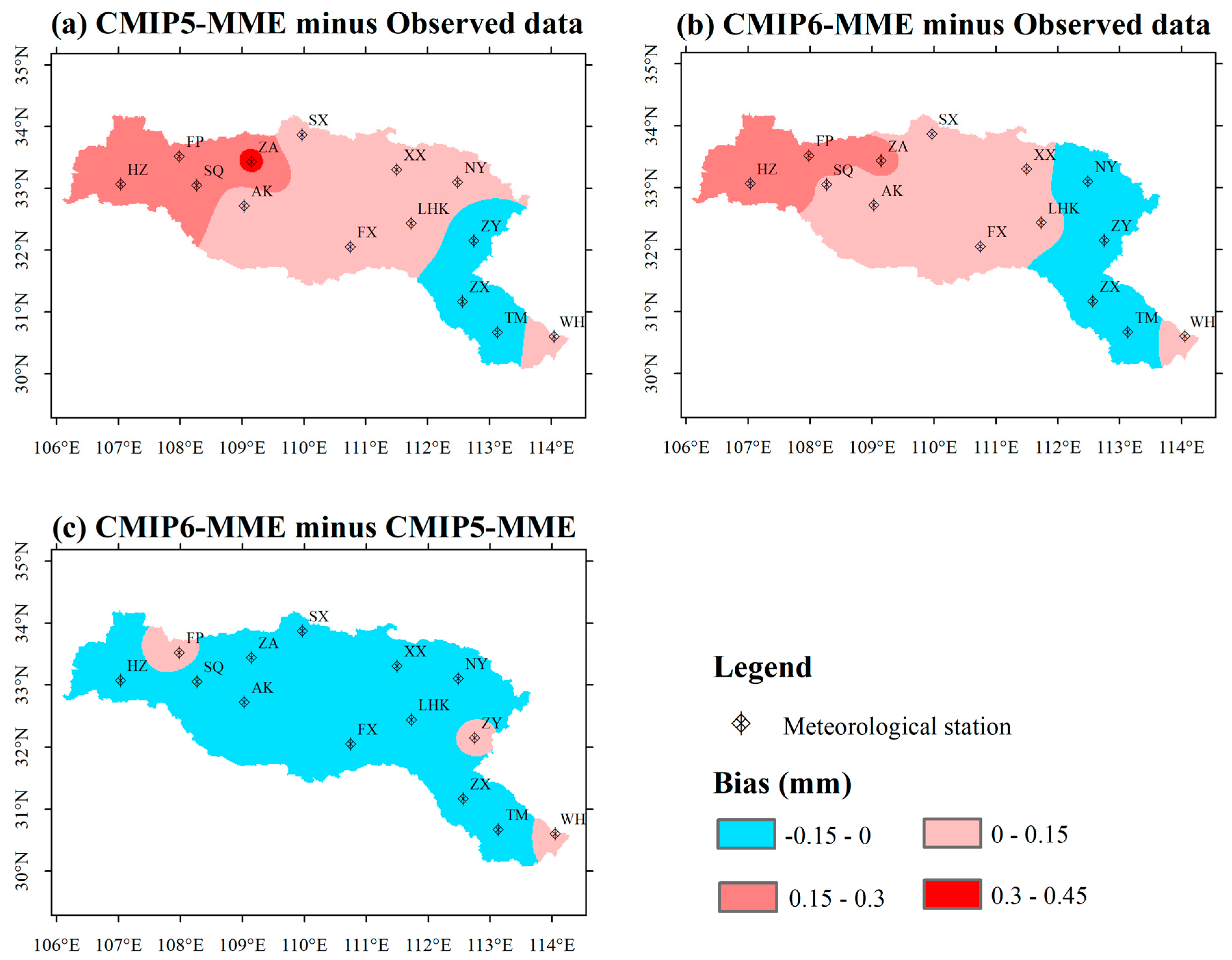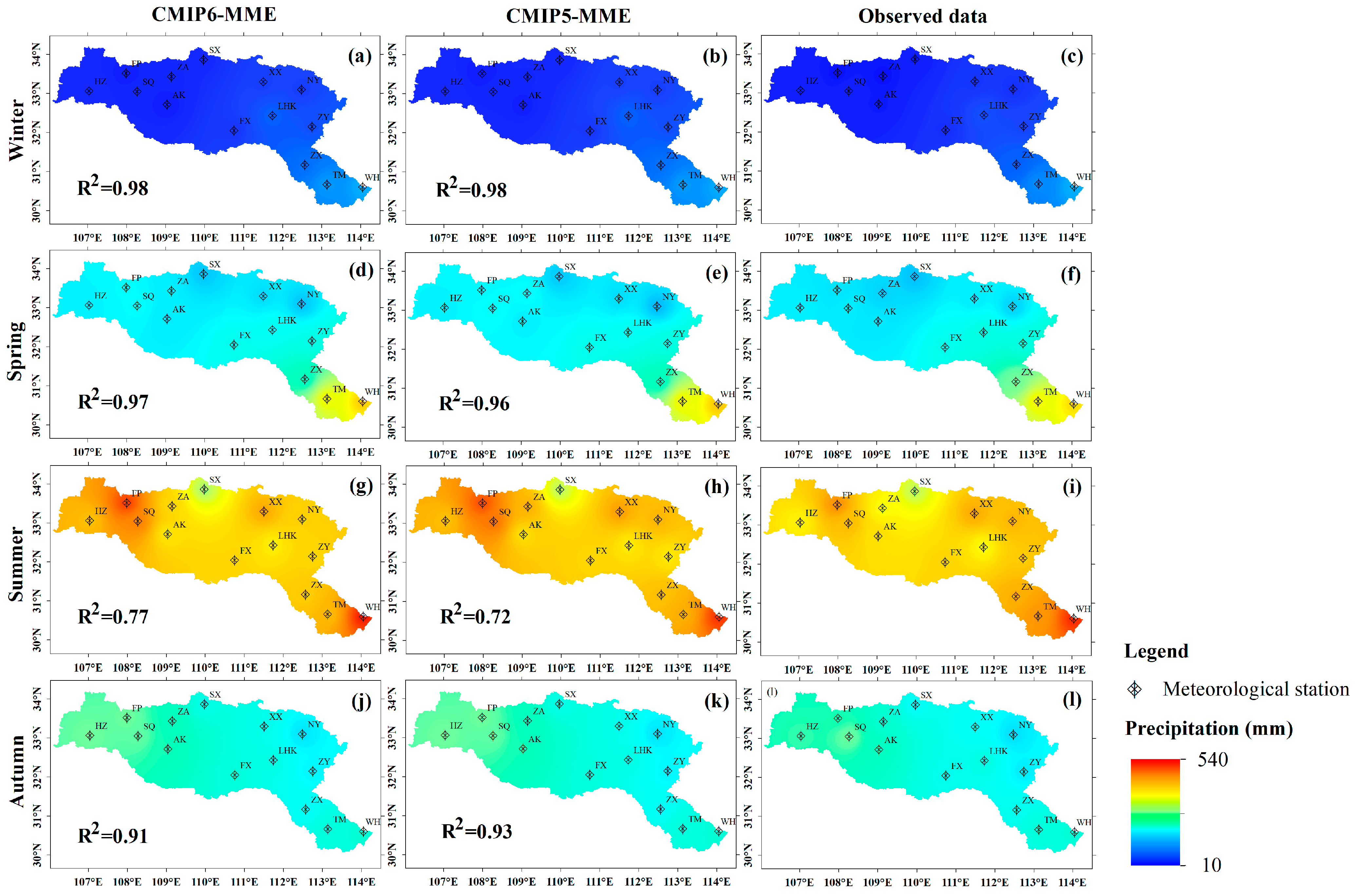Comparison of CMIP5 and CMIP6 Multi-Model Ensemble for Precipitation Downscaling Results and Observational Data: The Case of Hanjiang River Basin
Abstract
:1. Introduction
2. Materials and Methods
2.1. Study Region and Data Collection
2.2. Methods
2.2.1. Downscaling Method
2.2.2. Assessment of Downscaling Methodology
2.2.3. Comparison Indices and Methods
3. Results
3.1. Assessment of Downscaling Results
3.2. Spatial Performance Comparison of CMIP5-MME and CMIP6-MME Downscaled Precipitation
3.3. Temporal Performance Comparison of CMIP5-MME and CMIP6-MME Downscaled Precipitation
3.4. Seasonal Variation Comparison of CMIP5-MME and CMIP6-MME Downscaled Precipitation
4. Discussion
5. Conclusions
Author Contributions
Funding
Data Availability Statement
Acknowledgments
Conflicts of Interest
References
- Song, X.; Zhang, J.; Zhan, C.; Liu, C. Review for impacts of climate change and human activities on water cycle. J. Hydraul. Eng. 2013, 44, 779–790. [Google Scholar] [CrossRef]
- Chen, L.; Frauenfeld, O.W. A comprehensive evaluation of precipitation simulations over China based on CMIP5 multimodel ensemble projections. J. Geophys. Res. Atmos. 2014, 119, 5767–5786. [Google Scholar] [CrossRef]
- Xu, X.; Yang, D.; Yang, H.; Lei, H. Attribution analysis based on the Budyko hypothesis for detecting the dominant cause of runoff decline in Haihe basin. J. Hydrol. 2014, 510, 530–540. [Google Scholar] [CrossRef]
- Luo, M.; Liu, T.; Frankl, A.; Duan, Y.; Meng, F.; Bao, A.; Kurban, A.; De Maeyer, P. Defining spatiotemporal characteristics of climate change trends from downscaled GCMs ensembles: How climate change reacts in Xinjiang, China. Int. J. Climatol. 2018, 38, 2538–2553. [Google Scholar] [CrossRef]
- Shang, X.; Jiang, X.; Jia, R.; Wei, C. Land Use and Climate Change Effects on Surface Runoff Variations in the Upper Heihe River Basin. Water 2019, 11, 344. [Google Scholar] [CrossRef] [Green Version]
- Li, Z.; Li, Q.; Wang, J.; Feng, Y.; Shao, Q. Impacts of projected climate change on runoff in upper reach of Heihe River basin using climate elasticity method and GCMs (vol 716, 137072, 2020). Sci. Total. Environ. 2021, 766. [Google Scholar] [CrossRef] [PubMed]
- Eyring, V.; Bony, S.; Meehl, G.A.; Senior, C.A.; Stevens, B.; Stouffer, R.J.; Taylor, K.E. Overview of the Coupled Model Intercomparison Project Phase 6 (CMIP6) experimental design and organization. Geosci. Model. Dev. 2016, 9, 1937–1958. [Google Scholar] [CrossRef] [Green Version]
- Gusain, A.; Ghosh, S.; Karmakar, S. Added value of CMIP6 over CMIP5 models in simulating Indian summer monsoon rainfall. Atmos. Res. 2020, 232. [Google Scholar] [CrossRef]
- Jeong, D.I.; St-Hilaire, A.; Ouarda, T.B.M.J.; Gachon, P. A multi-site statistical downscaling model for daily precipitation using global scale GCM precipitation outputs. Int. J. Climatol. 2013, 33, 2431–2447. [Google Scholar] [CrossRef] [Green Version]
- Ta, Z.; Yu, Y.; Sun, L.; Chen, X.; Mu, G.; Yu, R. Assessment of Precipitation Simulations in Central Asia by CMIP5 Climate Models. Water 2018, 10, 1516. [Google Scholar] [CrossRef] [Green Version]
- Cherchi, A.; Fogli, P.G.; Lovato, T.; Peano, D.; Iovino, D.; Gualdi, S.; Masina, S.; Scoccimarro, E.; Materia, S.; Bellucci, A.; et al. Global mean climate and main patterns of variability in the CMCC-CM2 coupled model. J. Adv. Modeling Earth Syst. 2018. [Google Scholar] [CrossRef] [Green Version]
- Su, X.; Shao, W.; Liu, J.; Jiang, Y. Multi-Site Statistical Downscaling Method Using GCM-Based Monthly Data for Daily Precipitation Generation. Water 2020, 12, 904. [Google Scholar] [CrossRef] [Green Version]
- Khalili, M.; Van Nguyen, V.T. An efficient statistical approach to multi-site downscaling of daily precipitation series in the context of climate change. Clim. Dyn. 2016, 49, 2261–2278. [Google Scholar] [CrossRef]
- Chen, J.; Chen, H.; Guo, S. Multi-site precipitation downscaling using a stochastic weather generator. Clim. Dyn. 2017, 50, 1975–1992. [Google Scholar] [CrossRef]
- Salman, S.A.; Nashwan, M.S.; Ismail, T.; Shahid, S. Selection of CMIP5 general circulation model outputs of precipitation for peninsular Malaysia. Hydrol. Res. 2020, 51, 781–798. [Google Scholar] [CrossRef]
- Rao, X.; Lu, X.; Dong, W. Evaluation and Projection of Extreme Precipitation over Northern China in CMIP5 Models. Atmosphere 2019, 10, 691. [Google Scholar] [CrossRef] [Green Version]
- Rivera, J.A.; Arnould, G. Evaluation of the ability of CMIP6 models to simulate precipitation over Southwestern South America: Climatic features and long-term trends (1901–2014). Atmos. Res. 2020, 241. [Google Scholar] [CrossRef]
- Kim, Y.-H.; Min, S.-K.; Zhang, X.; Sillmann, J.; Sandstad, M. Evaluation of the CMIP6 multi-model ensemble for climate extreme indices. Weather. Clim. Extrem. 2020, 29. [Google Scholar] [CrossRef]
- Hao, W.; Hao, Z.; Yuan, F.; Ju, Q.; Hao, J. Regional Frequency Analysis of Precipitation Extremes and Its Spatio-Temporal Patterns in the Hanjiang River Basin, China. Atmosphere 2019, 10, 130. [Google Scholar] [CrossRef] [Green Version]
- Qin, Z.; Peng, T.; Singh, V.P.; Chen, M. Spatio-temporal variations of precipitation extremes in Hanjiang River Basin, China, during 1960–2015. Theor. Appl. Climatol. 2019, 138, 1767–1783. [Google Scholar] [CrossRef]
- Su, B.; Gemmer, M.; Jiang, T. Spatial and temporal variation of extreme precipitation over the Yangtze River Basin. Quat. Int. 2008, 186, 22–31. [Google Scholar] [CrossRef]
- Maurer, E.P.; Hidalgo, H.G. Utility of daily vs. monthly large-scale climate data: An intercomparison of two statistical downscaling methods. Hydrol. Earth Syst. Sci. 2008, 12, 551–563. [Google Scholar] [CrossRef] [Green Version]
- Li, X.; Babovic, V. Multi-site multivariate downscaling of global climate model outputs: An integrated framework combining quantile mapping, stochastic weather generator and Empirical Copula approaches. Clim. Dyn. 2018, 52, 5775–5799. [Google Scholar] [CrossRef]
- Li, X.; Zhang, K.; Babovic, V. Projections of Future Climate Change in Singapore Based on a Multi-Site Multivariate Downscaling Approach. Water 2019, 11, 2300. [Google Scholar] [CrossRef] [Green Version]
- Wang, R.; Zhang, Q.; Li, N.; Jiang, T. Variation of Precipitation in Hanjiang River Basin in the Period of 1961–2049. Resour. Environ. Yangtze Basin 2019, 28, 2743–2752. [Google Scholar] [CrossRef]
- Tian, J.; Zhang, Z.; Ahmed, Z.; Zhang, L.; Su, B.; Tao, H.; Jiang, T. Projections of precipitation over China based on CMIP6 models. Stoch. Environ. Res. Risk Assess. 2021, 35, 831–848. [Google Scholar] [CrossRef]
- Simonovic, S.P.; Schardong, A.; Sandink, D.; Srivastav, R. A web-based tool for the development of Intensity Duration Frequency curves under changing climate. Environ. Model. Softw. 2016, 81, 136–153. [Google Scholar] [CrossRef]
- Li, Z.; Liu, W.-Z.; Zhang, X.-C.; Zheng, F.-L. Assessing the site-specific impacts of climate change on hydrology, soil erosion and crop yields in the Loess Plateau of China. Clim. Chang. 2010, 105, 223–242. [Google Scholar] [CrossRef]
- Chen, J.; Brissette, F.P.; Chaumont, D.; Braun, M. Performance and uncertainty evaluation of empirical downscaling methods in quantifying the climate change impacts on hydrology over two North American river basins. J. Hydrol. 2013, 479, 200–214. [Google Scholar] [CrossRef]
- Zhang, Y.G.; Nearing, M.A.; Zhang, X.C.; Xie, Y.; Wei, H. Projected rainfall erosivity changes under climate change from multimodel and multiscenario projections in Northeast China. J. Hydrol. 2010, 384, 97–106. [Google Scholar] [CrossRef]
- Vaghefi, P.; Yu, B. Use of cligen to simulate decreasing precipitation trends in the southwest of western australia. Trans. Asabe 2016, 59, 49–61. [Google Scholar]
- Srivastava, A.; Grotjahn, R.; Ullrich, P.A. Evaluation of historical CMIP6 model simulations of extreme precipitation over contiguous US regions. Weather. Clim. Extrem. 2020, 29. [Google Scholar] [CrossRef]
- Zamani, Y.; Hashemi Monfared, S.A.; Azhdari moghaddam, M.; Hamidianpour, M. A comparison of CMIP6 and CMIP5 projections for precipitation to observational data: The case of Northeastern Iran. Theor. Appl. Climatol. 2020, 142, 1613–1623. [Google Scholar] [CrossRef]
- Sospedra-Alfonso, R.; Melton, J.R.; Merryfield, W.J. Effects of temperature and precipitation on snowpack variability in the Central Rocky Mountains as a function of elevation. Geophys. Res. Lett. 2015, 42, 4429–4438. [Google Scholar] [CrossRef]
- Ahmadi, M.; Kashki, A.; Dadashi Roudbari, A. Spatial modeling of seasonal precipitation–elevation in Iran based on aphrodite database. Model. Earth Syst. Environ. 2018, 4, 619–633. [Google Scholar] [CrossRef]
- Li, X.; Wang, L.; Guo, X.; Chen, D. Does summer precipitation trend over and around the Tibetan Plateau depend on elevation? Int. J. Climatol. 2017, 37, 1278–1284. [Google Scholar] [CrossRef]
- Sahoo, S.K.; Himesh, S.; Gouda, K.C. Impact of Urbanization on Heavy Rainfall Events: A Case Study over the Megacity of Bengaluru, India. Pure Appl. Geophys. 2020, 177, 6029–6049. [Google Scholar] [CrossRef]
- Kishtawal, C.M.; Niyogi, D.; Tewari, M.; Pielke, R.A.; Shepherd, J.M. Urbanization signature in the observed heavy rainfall climatology over India. Int. J. Climatol. 2010, 30, 1908–1916. [Google Scholar] [CrossRef] [Green Version]
- Kinnell, P.I.A. CLIGEN as a weather generator for RUSLE2. Catena 2019, 172, 877–880. [Google Scholar] [CrossRef]
- Beck, H.E.; van Dijk, A.I.J.M.; Levizzani, V.; Schellekens, J.; Miralles, D.G.; Martens, B.; de Roo, A. MSWEP: 3-hourly 0.25 degrees global gridded precipitation (1979-2015) by merging gauge, satellite, and reanalysis data. Hydrol. Earth Syst. Sci. 2017, 21, 589–615. [Google Scholar] [CrossRef] [Green Version]
- Sun, Q.; Miao, C.; Duan, Q.; Ashouri, H.; Sorooshian, S.; Hsu, K.-L. A Review of Global Precipitation Data Sets: Data Sources, Estimation, and Intercomparisons. Rev. Geophys. 2018, 56, 79–107. [Google Scholar] [CrossRef] [Green Version]
- Wu, J.; Gao, X. A gridded daily observation dataset over China region and comparison with the other dataset. Chin. J. Geophys. 2013, 56, 1102–1111. [Google Scholar] [CrossRef]
- Mehan, S.; Guo, T.; Gitau, M.; Flanagan, D.C. Comparative Study of Different Stochastic Weather Generators for Long-Term Climate Data Simulation. Climate 2017, 5, 26. [Google Scholar] [CrossRef]
- Wang, S.; Wang, Y. Improving probabilistic hydroclimatic projections through high-resolution convection-permitting climate modeling and Markov chain Monte Carlo simulations. Clim. Dyn. 2019, 53, 1613–1636. [Google Scholar] [CrossRef]
- Zhang, B.; Wang, S.; Wang, Y. Copula-Based Convection-Permitting Projections of Future Changes in Multivariate Drought Characteristics. J. Geophys. Res. Atmos. 2019, 124, 7460–7483. [Google Scholar] [CrossRef]











| Station ID | Station Name | Abbreviation | Latitude (N) | Longitude (E) | Average Annual Precipitation 1970–2005 (mm) |
|---|---|---|---|---|---|
| 57127 | Hanzhong | HZ | 33°04′ | 107°02′ | 853.52 |
| 57134 | Foping | FP | 33°31′ | 107°59′ | 910.92 |
| 57143 | Shangxian | SX | 33°52′ | 109°58′ | 683.58 |
| 57144 | Zhenan | ZA | 33°26′ | 109°09′ | 772.01 |
| 57156 | Xixia | XX | 33°18′ | 111°30′ | 851.51 |
| 57178 | Nanyang | NY | 33°06′ | 112°29′ | 777.54 |
| 57232 | Shiquan | SQ | 33°03′ | 108°16′ | 881.85 |
| 57245 | Ankang | AK | 32°43′ | 109°02′ | 826.32 |
| 57259 | Fangxian | FX | 32°03′ | 110°45′ | 831.05 |
| 57265 | Laohekou | LHK | 32°26′ | 111°44′ | 825.78 |
| 57279 | Zaoyang | ZY | 32°09′ | 112°45′ | 830.51 |
| 57378 | Zhongxiang | ZX | 31°10′ | 112°34′ | 964.83 |
| 57483 | Tianmen | TM | 30°40′ | 113°08′ | 1109.79 |
| 57494 | Wuhan | WH | 30°36′ | 114°03′ | 1259.42 |
| CMIP5 | Modeling Center and Country | CMIP6 | ||
|---|---|---|---|---|
| Model Name | Horizontal Resolution (Latitude × Longitude) | Model Name | Horizontal Resolution (Latitude × Longitude) | |
| BCC-CSM1-1 | 2.8125° × 2.8125° | Beijing Climate Center, China | BCC-CSM2-MR | 1.125° × 1.125° |
| BCC-CSM1-1-m | 1.125° × 1.125° | Beijing Climate Center, China | BCC-ESM1 | 2.81° × 2.81° |
| FGOALS-g2 | 3° × 2.8° | Institute of Atmospheric Physics, Chinese Academy of Sciences, China | FGOALS-g3 | 2.3° × 2° |
| GISS-E2-H | 2.5° × 2.5° | NASA Goddard Institute for Space Studies, USA. | GISS-E2-1-H | 1.25° × 1.25° |
| CMCC-CM | 0.75° × 0.75° | Centro Euro-Mediterraneo per I Cambiamenti Climatici, Italy | CMCC-CM2-SR5 | 1° × 1° |
| CMCC-CMS | 1.875° × 1.875° | Centro Euro-Mediterraneo per I Cambiamenti Climatici, Italy | CMCC-CM2-HR4 | 0.25° × 0.25° |
| MIROC5 | 1.4° × 1.4° | Japan Agency for Marine-Earth Science and Technology, Japan | MIROC6 | 1.4° × 1.4° |
| IPSL-CM5A-LR | 3.75° × 1.875° | Institut Pierre Simon Laplace, France | IPSL-CM6A-LR | 1.26° × 2.5° |
| CanESM2 | 2.8125° × 2.8125° | Canadian Centre for Climate Modelling and Analysis, Canada | CanESM5 | 2.81° × 2.81° |
| MPI-ESM-LR | 1.875° × 1.875° | Max Planck Institute for Meteorology, Germany | MPI-ESM1-2-LR | 1.5° × 1.5° |
Publisher’s Note: MDPI stays neutral with regard to jurisdictional claims in published maps and institutional affiliations. |
© 2021 by the authors. Licensee MDPI, Basel, Switzerland. This article is an open access article distributed under the terms and conditions of the Creative Commons Attribution (CC BY) license (https://creativecommons.org/licenses/by/4.0/).
Share and Cite
Wang, D.; Liu, J.; Shao, W.; Mei, C.; Su, X.; Wang, H. Comparison of CMIP5 and CMIP6 Multi-Model Ensemble for Precipitation Downscaling Results and Observational Data: The Case of Hanjiang River Basin. Atmosphere 2021, 12, 867. https://doi.org/10.3390/atmos12070867
Wang D, Liu J, Shao W, Mei C, Su X, Wang H. Comparison of CMIP5 and CMIP6 Multi-Model Ensemble for Precipitation Downscaling Results and Observational Data: The Case of Hanjiang River Basin. Atmosphere. 2021; 12(7):867. https://doi.org/10.3390/atmos12070867
Chicago/Turabian StyleWang, Dong, Jiahong Liu, Weiwei Shao, Chao Mei, Xin Su, and Hao Wang. 2021. "Comparison of CMIP5 and CMIP6 Multi-Model Ensemble for Precipitation Downscaling Results and Observational Data: The Case of Hanjiang River Basin" Atmosphere 12, no. 7: 867. https://doi.org/10.3390/atmos12070867
APA StyleWang, D., Liu, J., Shao, W., Mei, C., Su, X., & Wang, H. (2021). Comparison of CMIP5 and CMIP6 Multi-Model Ensemble for Precipitation Downscaling Results and Observational Data: The Case of Hanjiang River Basin. Atmosphere, 12(7), 867. https://doi.org/10.3390/atmos12070867









